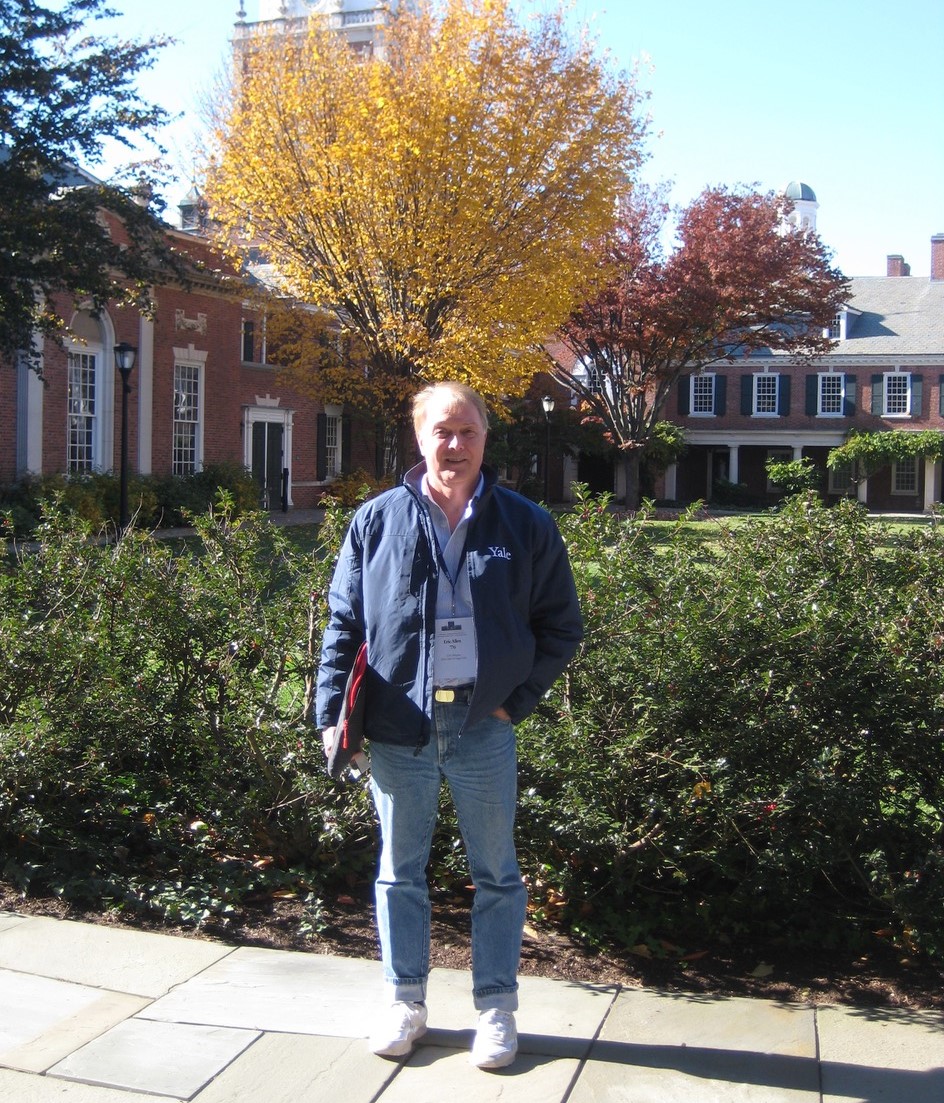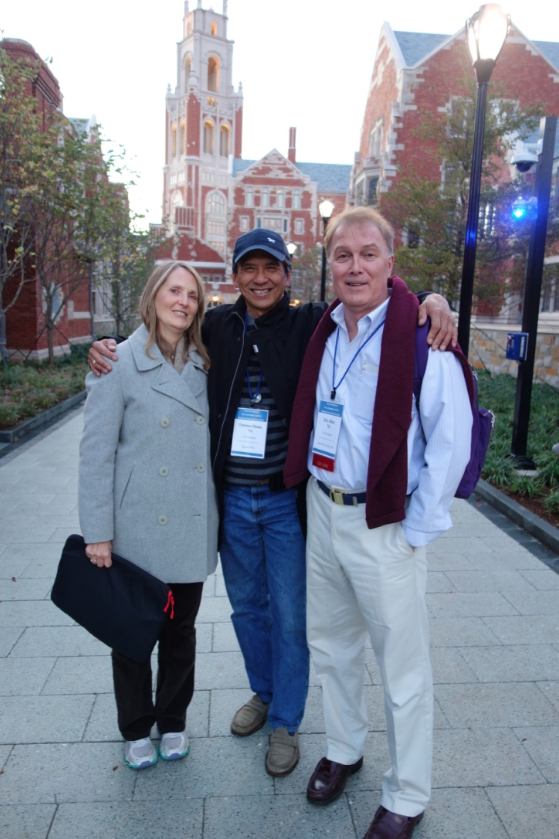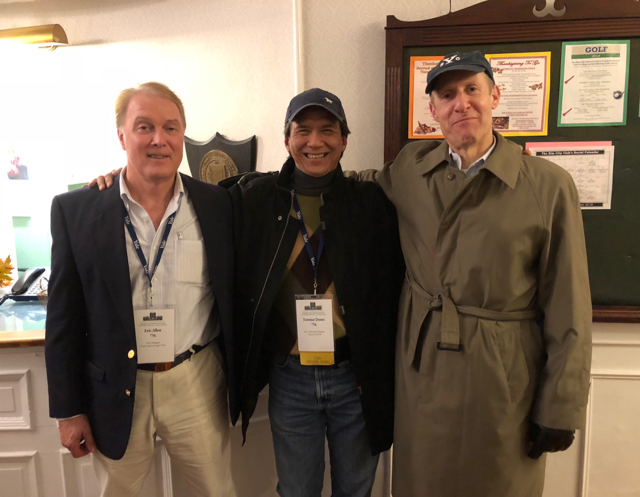
Last time I’d been to the Elm City, wide bell-bottom pants were a thing, and I had two pairs. One of them was plaid. And this had happened: in one corner of Silliman’s courtyard is a tree the size of Calhoun (now Hopper). Vijay was near its top. As I glanced, he descended, crash, crash, crash, crash, thud. He’d bounced off four limbs on his way to the ground. Two friends, playing backgammon feet away, looked up, asked after his health, then went back to their game.
Vijay lay there for a minute, perhaps two. Then he got up and headed for the library. It seemed to me a metaphor, even then, for the charmed nature of our college years, when nearly anything seems possible, and real setbacks unlikely.
That was then. Seven presidents later, and facing crumbling infrastructure, it takes me less time to comb my hair, more time to shave my ears. And I was on my way over the Cape Cod Canal to see campus again, on the fall weekend that alums gather from every crevice of the country, and many places outside of it, to hear from administrators and faculty about recent school news.
My wife and I glided down the Interstate, took the exit ramp for Grove Street, parked, and walked onto campus. The carillon pealed. Students rushed. If I’d had more homework to do, and felt less relaxed, I would have imagined I fit in. It felt familiar.
When you’ve bounced around a place for four years, you figure you’ve seen the sights. But Yale is so full of hidden corners – remarkable rooms and courtyards and gateways – you probably haven’t. We went through a doorway I’d never opened, down a hallway to an octagonal room. Today, a routine lecture room. On one wall, thirty feet of the most striking stained glass I’ve seen: a depiction of Education, with angels standing in for the Arts, Science, Religion, and Music. Other angels representing assorted virtues attend them. Sunlight lights the scene from behind. The effect is extraordinary.
But here, in an unknown lecture room? I looked it up. Simeon Chittenden went to college elsewhere, but he loved Yale. When his only daughter died too young, in his grief and desire to memorialize her, he came up with this window. If it looks well done, it’s the work of Louis Comfort Tiffany and his studio. At the time, this octagonal room was the main reading room of the College’s library, one of the most important spaces on campus.
It occurred to me that the campus we know now is a collection of spots like this, so many of them gifts reflecting one person’s heartache or their devotion. It is no accident that campus feels like a temple, sometimes. It is a repository for the emotions of hundreds, even thousands, of donors, and it has been coming together for 300 years.
***
The 2018 Assembly had a theme: Science at Yale. The next morning we gathered at Sprague Hall, wonderfully restored since I had a sophomore year date there, and President Salovey spoke. Any great university must be great in science, he said, and Yale is. He wishes Yale to be the leading global research institute that places the teaching of students at its center.

For a university, part of being great in science – but only one part – is providing capable buildings and state-of-the-art equipment. Toward that end, Science Hill has become more vibrant by the year. Sterling Chemistry Lab was recently gutted and rebuilt, attic to basement, with the latest in lab and lecture facilities. Wright Lab (a nuclear accelerator building during my years) is entirely repurposed for studying neutrinos and dark matter, hot topics at the smallest and largest scales of science. On Hillhouse is a new Institute for Quantum Studies. Beneath and behind Becton are new spaces for engineering instruction, and a “maker space” for student entrepreneurs. In environmental science: Forestry’s longtime building just finished a seven-year overhaul, and the school acquired the striking new Kroon Hall, a building of wood and glass full of auditoriums, other gathering spaces, and lecture halls. A new Environmental Science Center sits nearby, attached to Peabody Museum.
The very latest buzz involves Yale’s Science Building, rising in the footprint of Gibbs Laboratory. It holds innovative physics spaces, aquatics and insect labs, a rooftop greenhouse, cutting-edge imaging technology, a quantitative biology center, and a 500-seat lecture hall.
These buildings aim to provide more than space and extraordinary equipment, we were reminded. As the problems science engages become more complex, success depends not just on mastering one’s own field, but on engaging with others. These buildings intersperse lecture spaces and offices, laboratories and common areas, so that faculty and students from different fields are likely to run into each other, and then can easily find places to collaborate.
The new Science Building aims to be a gathering place for people in all of the sciences, much as the repurposed Hall of Graduate Studies is about to be a gathering place for those active in the Humanities, and the repurposed Commons a gathering space for all of the university.
Creating an environment that facilitates collaboration across fields is part of Yale’s mission. Professor Richard Nordhaus ’63, a Nobel laureate last year for his work in the economics of climate change mitigation, alluded to this when he described how Yale’s atmosphere had been essential in his work. Professor of Molecular Biophysics and Biochemistry Thomas Steitz (Nobel laureate 2009) said something similar: Yale might have provided the best environment in the world for his work mapping the structure of ribosomes.
While these buildings rose, it turns out, Yale also discussed what its priorities in science should be over the next decade. For more than a year and a half, 500 faculty members from every school of the University pondered what investments would lead to the greatest return, given the world’s needs and Yale’s capabilities. The conclusions: by a large margin, faculty members felt the highest priority area for investment was data science. The second priority: quantum science. The third: inflammation science (the biggest medical challenges all relate to inflammation, it turns out.) Priority four: climate change. Priority five: neuroscience.
President Salovey suggested that at no earlier moment in history might science have been poised to make larger contributions to the world’s problems. And the big contributions will likely require the collaboration of many people, working across disciplinary boundaries. That’s one reason that places like Yale matter.
***
Assemblies aren’t all work. The next day I went on a tour. The guy next to me said, “Hey, you were Silliman, too? Wait a minute ... Eric??!” It was my sophomore year suitemate, in those days a devotee of Kung Fu on TV, these days PBS’s best-known Tai Chi master.
That night we all went to a banquet. Another fellow said, “ Whoa ... Eric??!” It was a terrific guy from my senior year entryway, who said kind things I can’t repeat, due to early training in modesty.
And while the Assembly daytime events happened, my wife plumbed Manuscripts and Archives, freshly moved into a rehabbed space in Sterling Library. She had never been to campus until recently, had no ties to Yale growing up. But her great-great uncle taught at the Divinity School for decades, and Manuscripts has his papers.
A year ago, she had begun reading Uncle Frank’s letters from 1876, and finished with one announcing the birth of her own mother, years later. Working through the boxes and folders, she had reached a moment her grandparents might have spoken of. This year she read more from Frank’s youth and education, including his years at Yale College and then at the Divinity School.
Facing graduation, wondering whether to go into ministry or into education, he wrote President Dwight for advice. Yale was smaller then. With a literary grace not common in our own time, the president replied:
“I wish that all things in life were as clear to me as this, that your place is here, and your life’s mission to teach.”
I gulped when my wife described this.
***

Yale has been helping young people find their calling for some time now, and helping them find the environment and the people they need to progress.
Certainly, Yale is a place; one built by thousands and thousands of donors over all this time, into a warren of extraordinary and unexpected places. I think of Mr. Chittendon’s stained glass window, designed and made by Tiffany; or of Linonia and Brothers Library (a nook I always enjoyed in Sterling); or of the fantastical gargoyles around the Law School. You will remember your own special places.
But even more than a place, Yale is a community, of people who relish the life of the mind. And most of that community, by far, is outside New Haven. It is the 170,000 or so alums who have been touched by Yale and are now in spots all over the world, doing nearly anything you can imagine.
That community can still be a source of ideas, insights, and breakthroughs, as it was when we were together on campus. On campus it was easy to meet Elis in person. Now that we are “in the world,” we can find Yalies in our local club, or in Yale’s online directory or its different Facebook pages. Whatever one’s interests, whatever one’s activities, there are fellow alums who can shed light on one’s ideas, or even collaborate towards some goal.
The world needs what our community can accomplish. And we ourselves reach our promise best when interacting with others. I think the existence of the Yale community is an ongoing gift, to our own lives and to the world.
The presentations wound down. Late Friday there was a reception for those who have added much to Yale. On Saturday, a dramatic football game with Princeton. Among the rush of people leaving the Bowl, my wife and I pointed the car toward Cape Cod and our favorite shorebirds.
We were reminded of the meaning to our kind of being connected.
And, in one small corner of our brains, relieved we needn’t accessorize in orange.
***
Eric Allen grew up hearing that college towns, with all the different skills they contain, could accomplish anything. Some time well after Facebook appeared, he realized that a "town" needn't be people who actually live together.




